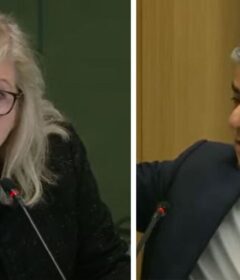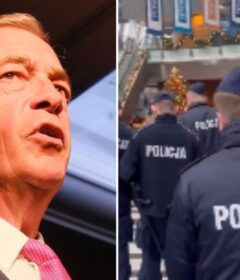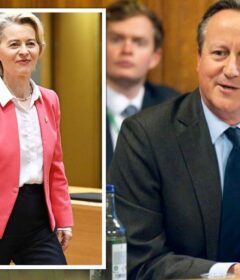Biden Inaugurated as the 46th President Amid a Cascade of Crises
WASHINGTON — Joseph Robinette Biden Jr. was sworn in as the 46th president of the United States on Wednesday, taking office at a moment of profound economic, health and political crises with a promise to seek unity after a tumultuous four years that tore at the fabric of American society.
With his hand on a five-inch-thick Bible that has been in his family for 128 years, Mr. Biden recited the 35-word oath of office swearing to “preserve, protect and defend the Constitution” in a ceremony administered by Chief Justice John G. Roberts Jr., completing the process at 11:49 a.m., 11 minutes before the authority of the presidency formally changes hands.
The ritual transfer of power came shortly after Kamala Devi Harris was sworn in as vice president by Justice Sonia Sotomayor, her hand on a Bible that once belonged to Thurgood Marshall, the civil rights icon and Supreme Court justice. Ms. Harris’s ascension made her the highest-ranking woman in the history of the United States and the first Black American and first person of South Asian descent to hold the nation’s second highest office.
In his Inaugural Address, Mr. Biden declared that “democracy has prevailed” after a test of the system by a defeated president, Donald J. Trump, who sought to overturn the results of an election and then encouraged a mob that stormed the Capitol two weeks ago to block the final count. But he called for Americans to put aside their deep and dark divisions to come together to confront the coronavirus pandemic, economic troubles and the scourge of racism.
“We must end this uncivil war — red against blue, rural versus urban, conservative versus liberal,” Mr. Biden said in the 21-minute address that blended soaring themes with folksy touches. “We can do this if we open our souls instead of hardening our hearts, if we show a little tolerance and humility, and if we’re willing to stand in the other person’s shoes, as my mom would say, just for a moment.”
Mr. Biden used the word “unity” repeatedly, saying that he knew it “can sound to some like a foolish fantasy” but insisting that Americans had emerged from previous moments of polarization and can do so again.
“We can join forces, stop the shouting and lower the temperature,” he said. “For without unity, there is no peace, only bitterness and fury. No progress, only exhausting outrage. No nation, only a state of chaos. This is our historic moment of crisis and challenge, and unity is the path forward.”
The ceremony on a chilly, breezy but sunny day with a brief smattering of snowflakes brought to a close the stormy and divisive four-year Trump presidency. In characteristic fashion, Mr. Trump once again defied tradition by leaving Washington hours before the swearing in of his successor rather than face the reality of his own election defeat, although Mike Pence, his vice president, did attend.
Mr. Trump flew to Florida, where he plans to live at his Mar-a-Lago estate. But within days, the Senate will open the former president’s impeachment trial on the charge that he incited an insurrection by encouraging the mob that attacked the Capitol on Jan. 6 in an attempt to stop the formal counting of the Electoral College votes ratifying his defeat.
The sight of the nation’s newly installed president and vice president on the same West Front of the Capitol occupied just two weeks ago by the marauding pro-Trump crowd underscored how surreal the day was. Unlike most inaugurals suffused with joy and a sense of fresh beginning, the festivities on the nation’s 59th Inauguration Day served to illustrate America’s troubles.
The Presidential Inauguration ›
How to Follow Today’s Inauguration
-
- Our briefing will track the highlights, takeaways and key moments of the day.
- In our live reporter chat, watch the inauguration ceremony and follow along as reporters discuss the day moment by moment.
- See scenes from the Capitol as Biden prepares to take his oath in our live blog.
Amid fear of further violence, Washington has been transformed into an armed camp, with some 25,000 National Guard troops joining thousands of police officers and a wide swath of downtown blocked off. With the coronavirus pandemic still raging, Americans were told to stay away, leading to the eerie spectacle of a new president addressing a largely empty National Mall, filled not with people but with flags meant to represent the absent crowd.
Many of the usual inaugural customs were scrapped because of the virus, including a lunch with congressional leaders in Statuary Hall, the boisterous parade down Pennsylvania Avenue and the gala evening balls where the new president and his wife are typically expected to dance.
Instead, Mr. Biden will review military units on the East Front of the Capitol and later proceed to the White House escorted by marching bands from all branches of the military as well as university drum lines from the University of Delaware and Howard University, the alma maters of the new president and vice president, respectively. After that, a virtual “Parade Across America” will feature performances live streamed from 56 states and territories.
To symbolize the theme of national unity that Mr. Biden sought to project, he will be joined by three former presidents — Barack Obama, George W. Bush and Bill Clinton — to lay a wreath at the Tomb of the Unknowns at Arlington National Cemetery before the parade. Instead of the formal dances, the new first and second couples will take part in a 90-minute televised evening program hosted by the actor Tom Hanks.
If the pomp and circumstance were constrained by the challenges of the day, Mr. Biden’s determination to get off to a fast start unraveling the Trump presidency was not. He planned to sign 17 executive orders, memorandums and proclamations in the late afternoon aimed at reversing many of the major elements of the last administration, a dramatic repudiation of his predecessor and a more expansive set of Inauguration Day actions than any in modern history.
Among other moves, he planned to issue a national mask mandate for federal workers and federal property, seek the extension of an eviction pause and student loan relief, rejoin the Paris climate accord, suspend construction of Mr. Trump’s border wall, lift the travel ban on certain predominantly Muslim countries, bolster the program allowing young immigrants brought into the country illegally as children to stay, bar discrimination by the federal government based on sexual orientation or gender identity and impose a moratorium on oil and natural gas leases in the Arctic National Wildlife Refuge.
Latest Updates
Rarely if ever has a new president moved to reverse so much of his predecessor’s work on his first day in office, but Mr. Biden was intent on signaling a clean break from Mr. Trump. Some of the orders were more symbolic than substantive, and enduring change will still require legislation. To that end, Mr. Biden planned to unveil on Wednesday an immigration overhaul providing a path to citizenship for 11 million people living in the country illegally that will have to be approved by Congress in what is sure to be a contentious debate.
Commanding attention in Congress will be a challenge, with Mr. Trump’s trial likely consuming the Senate for days or weeks. As it stands, the Senate appeared unlikely to confirm any of Mr. Biden’s cabinet choices on Inauguration Day, another breach of custom. Mr. Trump had two of his cabinet secretaries confirmed on the day he took office, while Mr. Obama and Mr. Bush each had seven.
With Ms. Harris’s inauguration, the Senate, evenly divided with 50 Democrats and 50 Republicans, now flips to the Democrats thanks to her tiebreaking vote as the chamber’s president. Senator Chuck Schumer of New York becomes the Democratic majority leader and hopes to create two parallel tracks so it can consider both nominations and legislation even as it conducts the Trump trial.
Mr. Biden hoped to use his Inaugural Address to strike a sharply different tone from his predecessor, who favored provocation over conciliation. Mr. Biden began working on it before Thanksgiving in a process run by his longtime adviser, Mike Donilon. He received help from Jon Meacham, the historian who is serving as an outside informal adviser, as well as from Vinay Reddy, his speechwriter, while relying on his sister, Valerie Biden Owens, who has long been an important sounding board.
But even as the new president called for unity, he wanted to use the speech to call out racism in the wake of the George Floyd killing and the siege of the Capitol by extremists. And while he did not want to cite Mr. Trump by name, he talked about the need for truth and the consequences of lies after four years in which the president made tens of thousands of false or misleading statements.
Beyond age, gender and race, Mr. Biden could hardly be more of a contrast to the president he succeeded. A longtime senator, former vice president and consummate Washington insider, Mr. Biden prides himself on his experience working across the aisle and hopes to forge a partnership with Senator Mitch McConnell of Kentucky, the minority leader, and other Republicans.
Garrulous and loquacious, known for an incandescent smile, a sometimes overly familiar shoulder rub and a proclivity for gaffes, Mr. Biden practices the sort of feel-your-pain politics of empathy mastered by Mr. Clinton and the call-me-anytime politics of relationships exemplified by the first President George Bush.
At 78, Mr. Biden is the oldest president in American history — older on his first day in office than Ronald Reagan was on his last — and even allies quietly acknowledge that he is no longer at his prime, meaning he will be constantly watched by friends and foes alike for signs of decline. But he overcame the doubts and the obstacles to claim the prize of his lifetime nearly 34 years after kicking off the first of his three presidential campaigns.
While he has strong center-left beliefs at his core, he is not ideologically driven, willing and even eager to move with the political center of gravity. The progressive wing of his party remains skeptical and he may find it daunting to hold together his electoral coalition, whose main point of agreement was shared antipathy for Mr. Trump.
Mr. Biden arrives at the pinnacle of power with a tailwind of public support. Fifty-seven percent of Americans view him favorably, according to Gallup, a higher rating than Mr. Trump ever saw in office, and 68 percent approve of Mr. Biden’s handling of the transition. But the vast majority of the public believes the country is on the wrong track and, in a measure of the impact of Mr. Trump’s drumbeat of false allegations of election fraud, 32 percent told CNN pollsters that they did not believe Mr. Biden won the election legitimately.
Mr. Biden and Ms. Harris bring new diversity to the top echelon of government. Mr. Biden is only the second Catholic president after John F. Kennedy and Ms. Harris broke multiple gender and racial barriers in winning the vice presidency. The Cabinet that Mr. Biden assembled has record numbers of women and people of color as well as the first gay person to lead one of the statutory Cabinet departments.
Mr. Biden, who spent Tuesday night at Blair House, the presidential guest quarters across Pennsylvania Avenue from the White House, began his public day at 8:50 a.m. when he departed for a service at the Cathedral of St. Matthew the Apostle with his wife, Jill Biden, along with Ms. Harris and her husband, Doug Emhoff. Joining them were congressional leaders of both parties, including Mr. McConnell.
That too was a change in tradition, as most new presidents before taking the oath worship at St. John’s Church, the Episcopal parish across Lafayette Square from the White House. But St. Matthew has its own presidential history as the site of Kennedy’s funeral.
Among those attending the swearing-in ceremony at the Capitol were the three former presidents and their wives, Hillary Clinton, Laura Bush and Michelle Obama, as well as former Vice President Dan Quayle. In addition to Chief Justice Roberts and Justice Sotomayor, four other members of the Supreme Court were present: Justice Elena Kagan and all three of Mr. Trump’s appointees, Justices Neil M. Gorsuch, Brett Kavanaugh and Amy Coney Barrett.
Mr. Pence and his wife Karen Pence received bipartisan applause when they arrived at the Captiol in appreciation for their show of respect for the transition of power despite Mr. Trump’s snub. It was Mr. Pence’s first visit since he was rushed out of the Senate chamber two weeks ago to escape the pro-Trump mob, some of whom chanted “Hang Mike Pence” because he refused to try to block the counting of the Electoral College votes as Mr. Trump had demanded.
Performing at the ceremony were Lady Gaga, Jennifer Lopez and Garth Brooks. Set to join Mr. Hanks for the evening performance dubbed “Celebrating America” at 8:30 p.m. were stars including Kerry Washington, Bruce Springsteen, Eva Longoria, Lin-Manuel Miranda and Demi Lovato.
Celebrity celebration will bracket demonstrations of getting down to business. Mr. Biden will sign his orders and memorandums in the Oval Office at 5:15 p.m. to be followed a half-hour later by a virtual swearing-in of his staff. At 7 p.m., Jen Psaki, the new White House press secretary, will hold her first daily briefing, re-establishing a regular opportunity for reporters to question the White House that had all but disappeared under Mr. Trump.
The Bidens will then spend their first night in the White House, completing a journey that officially began in 1987 and unofficially much earlier. These were not the circumstances the new president might have imagined arriving at 1600 Pennsylvania Avenue when he set out on this path, but history always has its surprises.
Source: Read Full Article



